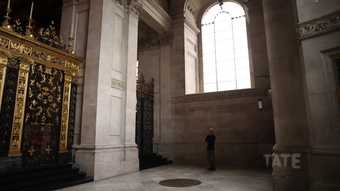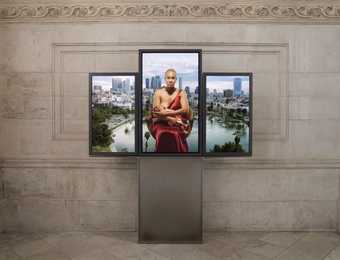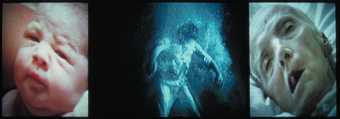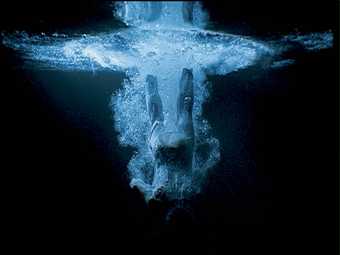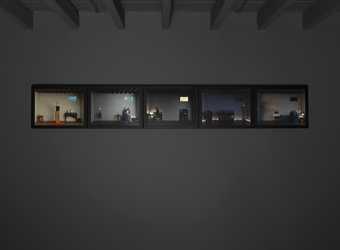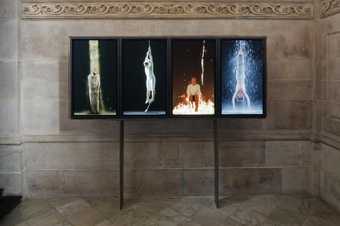R1: We have a wall at the end of the choir isle when you come into St Paul’s. Right now we’ve put a place for four plasma screens to be side by side in the vertical format. So, they’re narrow and long, not wide, and these represent four examples of martyrdom in a certain kind of way.
R2: The whole notion of martyrdom is that you’ve accepted your fate and that you are sacrificing yourself for some higher good or for some ideal that you have inside. And, we’re meeting these four people on these screens at a time when they’ve already accepted it.
R1: You have John Haigh who is the water person. And, he’s left for dead and then he’s hoisted up actually. There we go. And he’s literally hoisted upside down with his arms out.
Hold that. Hold that.
R1: And it’s the position that St Peter was crucified in. It’s one of the most painful ways in the Roman Empire to kill someone. And, so, he’s upside down, arms out, like a piece of meat hanging down and then slowly, again, he kind of wakes up again, sees where he is and then he gathers that strength again. And, then this water comes down on him, pours on him and buffets him. He’s moved around with it and stuff like that and then finally he gets the strength. And, then he breaks through and he ascends.
Start turning off the water little by little.
R1: His whole body actually comes up and goes right up out of frame and then you just see drops after that at the end until little drips happen and then it’s gone, he’s gone. And that’s the first one.The second one is wind, the wind and that’s done by Sarah. And, she’s battling the wind, that’s her protagonist. The wind happens and it gets stronger and stronger and then there’s this tussle again and then she breaks through that. She sees where she is, she knows she can do this, she knows that she can continue.
A little bit more, bring it up a little bit more. David, don’t let her spin.
R1: And then there’s the earth, the earth. The earth is, of course, the earth itself. And, that’s an image of a person who’s underground, who’s got dirt on them and stuff and is trying to find the way out.
Arms down, slowly.
R1: And that dirt, that element is actually going to be run backwards. So, instead of the earth just falling down, falling down, crushing this guy it’s a pile of earth and you see a hand and a leg and stuff like that and you realise it’s a part of a person. And, then they, sort of, come to the surface.
Heavy sifting begin.
R1: And then out of that can, kind of, come this realisation that you can put all those parts together and then suddenly things can begin rising up and going, in other words, backwards, going to run the whole thing backwards and so the whole thing gets, like, pulled up. The fire work is really intense. We’re trying to gather together multiple takes from different angles so that we can bring together multiple things in the same frame.
R2: Looks really, really good and the colours are going to just really bounce off that shirt.
R3: Yeah, because, I know, that’s…then I die. I go up in smoke. It’s a black thing.
R1: He wakes up and he realises, like, he’s in a really bad situation with fire around him ready to burn him alive. And, so then he has to come out of this cocoon and really begin to fight back. So, he gets the strength miraculously to get to that point, he breaks through that and then you begin to see light at the end of the tunnel and things start calming down. And, all of a sudden then he can look upward, outward and feel that he finally broke through. And he’s, quote unquote, seen the light. What I learned from this whole experience is the fact that what you’re seeing here is not the image of the martyrs as we would see them through a camera. But we’re actually now inside the martyrs. So, I think that’s a very important distinction; that this is about what the people are going through internally, not externally.
R2: I, kind of, brought in the four elements because those are forces of nature. Death is a force of nature and they, kind of, represent the rage of these forces. The most intense of going through death and transcendence into the light, if you will.
R4: To bring a work of this quality into this great cathedral adds a dimension, I think, to the cathedral but it also adds a dimension to the work. You are immediately reminded of all the great works of art that have dealt with those themes and you think of yourself in the great cathedrals of Europe and it feels entirely natural.

